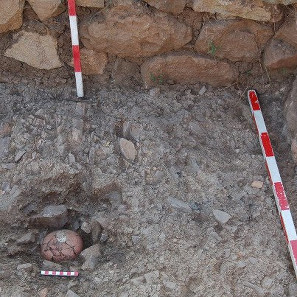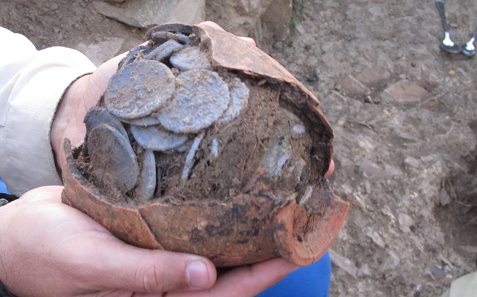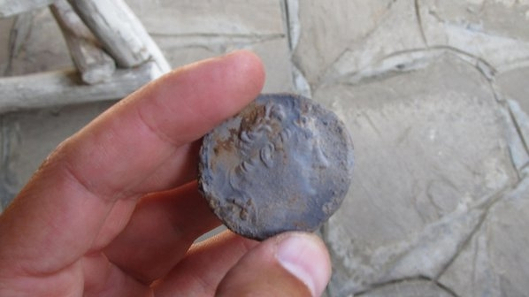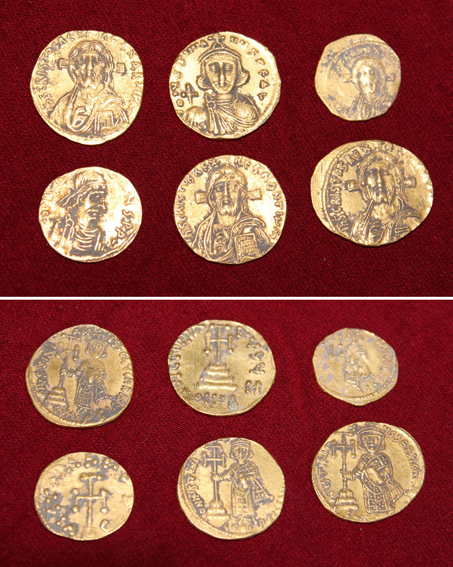by Evgeni Paunov
April 18, 2013 – On one hand the summer of 2012 was fertile and on the other – inspiring due to its new numismatic discoveries in the Western Black Sea region. Indeed, three highly interesting coin hoards came into existence as a result of regular archeological excavations carried out in the area.
Hoard A (Sozopol). Photo: National Archaeological Institute with Museum and courtesy of Prof. Krastina Panayotova, Sofia.
First, in late June while digging the sand dunes of the ancient necropolis of Apollonia Pontica at Sozopol, the Bulgarian archaeologists unearthed a small clay jug set in a family burial enclosure. It contained 225 bronzes of the 4th century BC preserved in perfect condition. All coins belong to the local Greek mint of Apollonia with its typical legends.
Indeed, the obverse of the smaller pieces bear the head of the god-patron Apollo, and of the larger ones – the God seated on a round omphalos (the centre, “navel” of the world). Reverses of both types depict the civic emblem (parasemon) of Apollonia – a bicornuate anchor, a cray-fish and the letter A.
An additional legend of the smaller coins (150 pieces) reads DI (dichalkie) – or equal to two coppers; as the bigger denomination – 75 coins in total (c. 20 mm) bear the names of city’s magistrates, and respectively it should have been equal to four coppers (chalkoi). A further numismatic study of this rare hoard will give precision on the chronology, denominational system and the output of the mint of Apollonia Pontica during its peak in the 4th c. BC. However, the exact reason for its concealment in Apollonia cemetery remains unclear for now.
Hoard B (Sinemorets). View of Sinemorets coastline with the hoard findspot (right at the single oak tree). Photo Alex Popov/Panoramio.
Second, in late September 2012 at Sinemorets – a small resort further south from Sozopol near the modern Bulgarian-Turkish border, an exceptional find has been made. Right on a flat plateau with a strategic position overlooking the mouth of Veleka river into the sea, a small fortification was built by the Thracians in the 3rd century BC and later it was abandoned.
Hoard B (Sinemorets). Photo: Bulphoto Agency and courtesy of Prof. Ivan Karayotov.
Sometime after, possible late 2nd to early 1st c. BC in front of one of its towers, a clay pot hoard of silver tetradrachms was hidden not too deep in the ground. It contains exactly 199 coins, carefully arranged in the vessel. All the coins are dating from the late Hellenistic period and the wars between Mithridates VI Eupator, the mighty king of Pontus, and the Roman Republic.
Hoard B (Sinemorets). Photo: Bulphoto Agency and courtesy of Prof. Ivan Karayotov.
According to the first numismatic examination carried out by Professor Ivan Karayotov, the most numerous are the silver issues of city of Byzantium of Lysimachos-type (head of Alexander to right with diadem and horn of Ammon / Athena enthroned to left, holding Nike, trident in exergue) – 146 coins of the late style (see links below).
Hoard B (Sinemorets). A silver tetradrachm of the Thracian king Mostis. Photo: Bulphoto Agency.
Next, the tetradrachms of the Thracian king Mostis follow; until recently accepted for being very rare. They enumerate to 36 coins, this way nearly tripling the extant 15 specimens. The Sinemorets hoard also comprises coins of the Bithynian kings Prusias II (1) and Nicomedes II (13 pieces), and few issues of the nearby coastal cities of Odessos, Mesambria (5 altogether) and Cyzicus (1).
The beautiful Hellenistic coins from Sinemorets are not yet cleaned in Sofia Archaeological Museum, having the so-called horn-silver encrustation resulting from a lead plate positioned on the top of the clay jug. The excavator Mrs. Daniela Agre – had promised a fast archaeological publication, which hopefully will be followed by a thorough numismatic study, is much awaited.
Hoard C (Banevo). Photo: Courtesy of Archaeological Museum of Burgas.
Thirdly, smaller hoard was uncovered not far from the Black Sea coast. It derives from the village of Banevo near Burgas – the famous mineral baths of ancient Aquae Calidae and medieval Thermopolis. It contained six Byzantine gold coins of the 7th century – four solidi and two semisses (half a solidus) as well as two silver finger-rings. One of the two semissis belong to Emperor Constantine IV Pogonatus (668-685) and the remaining five coins belong – to his son Justinian II, known as Rhinotmetus (the Split-nosed), dating of his first reign, 685–695 (of the types DOC 7g; MIB 8a (4) and DOC 6; MIB 7 (1)), all struck at Constantinople.
Particularly worth to mention is the exceptional frontal portrait of Christ presented on the reverse of Justinian II solidi, accepted as one of the masterpieces of Byzantine art of the pre-iconoclastic period. All coins of this period are usually very rare and valuable, this being especially valid for the semissis of Justinian II (type DOC 10; MIB 12; top right photo). This small but interesting hoard was a personal wealth hidden in emergency, most possibly related with wars between Byzantium and Bulgaria in the late 7th or early 8th century.
The numismatic value of these three hoards is significant and therefore it is everyone hope that forthcoming publications that allow further study will come in foreseeable future. We shall wait and see.
You can find a TV-report about the Sozopol hoard discovery in Bulgarian here.
A short report on the Sozopol hoard (in English) is available on the website of the National Institute of Archaeology.
If you understand Bulgarian you may read more detailed first examination and announcement on the Sinemorets hoard by Professor Ivan Karayotov on that site.
And also in Bulugarian is written another note by Prof. Karayotov on the Sinemorets hoard.
TV-reports on the hoard from Sinemorets (as always in Bulgarian only) offer this website …
… and another one this.










